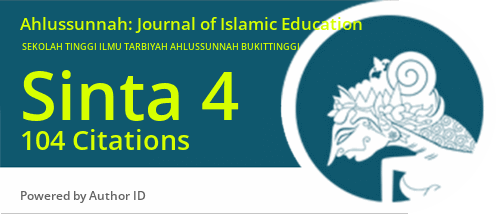Approach and Communication in Learning
DOI:
https://doi.org/10.58485/jie.v4i1.311Keywords:
Learning approaches, communication in learningAbstract
This study discusses approaches and communication in learning as two crucial aspects that influence the effectiveness of the educational process. Using library research, this study reviews various current literature, books, and journals that discuss the theory and practice of learning approaches and communication. The main focus of this study is to understand how appropriate learning approaches can support effective communication processes between teachers and students, thus creating productive and meaningful learning interactions. The results of the study indicate that adaptive and communicative learning approaches are crucial in increasing student engagement and understanding. Furthermore, clear, open, and interactive communication is also a determining factor for successful learning. Communication barriers that arise can be minimized through the implementation of appropriate communication strategies by teachers. This study provides a theoretical contribution to the development of learning models oriented towards interaction and effective communication in today's educational context.
Downloads
References
Adel, S., Athari, Z., Febriani, A., Oktavia, G. ., & Burhanudin, B. (2025). The Qur’an as a Source of Solutions for the Global Moral Crisis. Journal of Quranic Teaching and Learning, 1(2), 18-33. https://joqer.intischolar.id/index.php/joqer/article/view/10
Agus Suprijono. (2015). Cooperative Learning: Teori dan Aplikasi PAIKEM (p. 105).
Aryanti, Y., Mutathahirin, M., Rahman, I., & Mulyani, R. (2022). Teacher Analysis Study According to Imam Al Ghazali in the Book of Al Adab Fi Al-Din. Ahlussunnah: Journal of Islamic Education, 1(2), 46-58. https://doi.org/10.58485/jie.v1i2.177
Asmara, Y., & Nindianti, D. S. (2019). Urgensi Manajemen Kelas Untuk Mencapai Tujuan Pembelajaran. SINDANG: Jurnal Pendidikan Sejarah Dan Kajian Sejarah, 1(1), 12–24. https://doi.org/10.31540/sdg.v1i1.192
Bruce R. Joyce. (2015). Marsha Weil, dan Emily Calhoun, Models of Teaching, 9th ed (p. 7).
Daryanto. (2017). Media Pembelajaran (p. 54).
Dasrizal, D., Rambe, K. F., Sihombing, C. D., Khalid, E., & Safitri, D. A. (2025). Distortion of Quranic Interpretation on Socialmedia: An Analysis of the Spread of Misleading Meanings. Journal of Quranic Teaching and Learning, 1(2), 65-82. https://joqer.intischolar.id/index.php/joqer/article/view/8
Efendi, E., Ramadhani, R., Kamil, R. A., & Rahman, I. (2022). The Effect Of Building The Islamic Character Of Students At Wisma Padang State University. Jurnal Kepemimpinan dan Pengurusan Sekolah, 7(3), 271-280. https://doi.org/10.34125/jkps.v7i3
Engkizar, E., Jaafar, A., Alias, M. F. B., Guspita, R., & Albizar, A. (2025). Utilisation of Artificial Intelligence in Quranic Learning: Innovation or Threat?. Journal of Quranic Teaching and Learning, 1(2), 1-17. https://joqer.intischolar.id/index.php/joqer/article/view/7
Engkizar, E., Jaafar, A., Masuwd, M. A., Rahman, I., Datres, D., Taufan, M., Akmal, F., Dasrizal, D., Oktavia, G., Yusrial, Y., & Febriani, A. (2025). Challenges and Steps in Living Quran and Hadith Research: An Introduction. International Journal of Multidisciplinary Research of Higher Education (IJMURHICA), 8(3), 426–435. https://doi.org/10.24036/ijmurhica.v8i3.396
Engkizar, E., Jaafar, A., Sarianto, D., Ayad, N., Rahman, A., Febriani, A., ... & Rahman, I. (2024). Analysis of Quran Education Problems in Majority Muslim Countries. International Journal of Islamic Studies Higher Education, 3(1), 65-80. https://doi.org/10.24036/insight.v3i1.209
Engkizar, E., Jaafar, A., Taufan, M., Rahman, I., Oktavia, G., & Guspita, R. (2023). Quran Teacher: Future Profession or Devotion to the Ummah?. International Journal of Multidisciplinary Research of Higher Education (IJMURHICA), 6(4), 196-210. https://doi.org/10.24036/ijmurhica.v6i4.321
Engkizar, E., Muslim, H., Mulyadi, I., & Putra, Y. A. (2025). Ten Criteria for an Ideal Teacher to Memorize the Quran. Journal of Theory and Research Memorization Quran, 1(1), 26-39. https://joesmiq.intischolar.id/index.php/joesmiq/article/view/54
Euis Kurniati. (2020). Komunikasi Guru dan Siswa (p. 85).
Eva. (2022). Implementasi Pendekatan Interaktif dalam Pembelajaran PAI di Kelas SD. GUAU, 3(1), 12.
Fitria. (2020). Komunikasi Islam: Strategi Pembelajaran PAI di SMA. Edukasi Islami, 12(3), 77.
Gunawan. (2019). Pendekatan Contextual Teaching and Learning dan Aplikasinya dalam Pembelajaran PAI di Sekolah. PEDAGOGIK, 6(2), 20.
Halik. (2015). Metode Pembelajaran Perspektif Pendidikan Islam. Journal Al- "Ibrah, 1 (1).
Harahap, N. F., Anjani, D., & Sabrina, N. (2021). Analisis Artikel Metode Motivasi dan Fungsi Motivasi Belajar Siswa. Indonesian Journal of Intellectual Publication, 1(3), 198–203. https://doi.org/10.51577/ijipublication.v1i3.121
Jainab. (2025). Mengembangkan Kemampuan Komunikasi Siswa melalui Pembelajaran PAI Menggunakan Metode Hapalan. Jurnal Ilmu Tarbiyah Dan Keguruan, 3(1), 29.
Kadar M. (2019). Konstruksi Teori Belajar Qur’ani (p. 83).
Maulidyah. (2024). Pola Komunikasi Guru terhadap Peserta Didik dalam Pembelajaran PAI. Cendikia, Cendikia, 23.
Mawardi. (2023). Komunikasi Efektif dalam Pembelajaran PAI. PILAR, 1(1), 15.
Munib. (2022). Inovasi Pembelajaran di Era Merdeka Belajar (p. 103).
Ngadinem. (2023). Komunikasi Guru PAI dalam Pembelajaran. Jurnal Kualitas Pendidikan, 1(1), 9.
Nirmala. (2021). Peran Komunikasi Guru PAI dalam Meningkatkan Motivasi Belajar Siswa. Iqra, 16(2), 42.
Rahman, I., Iskandar, M. Y., Kustati, M., & Sepriyanti, N. (2024). Sustainable Development: Implementation of The Talqin Method In Memorizing The Quran. Jurnal Kepemimpinan dan Pengurusan Sekolah, 9(1), 99-108. https://doi.org/10.34125/jkps.v9i1.355
Rahman, I., Kaema, M. T., Nurhapipah, N., Nelwati, S., Sabri, A., & Rahmanda, R. (2024). Systematic Literature Review: Analysis of Project-based Learning Models from Elementary to High School. Al-Ashri: Ilmu-Ilmu Keislaman, 9(2), 53-66. https://ojs.stai-bls.ac.id/index.php/Al-Ashri/article/view/119
Rahman, I., Wati, W., Putri, N., Wulandari, R., & Habibi, U. A. (2025). Commercialization of Quranic Tahfidz Houses in Indonesia: Da’wah or Business?. Journal of Quranic Teaching and Learning, 1(2), 34-48. https://joqer.intischolar.id/index.php/joqer/article/view/6
Rasdiany, A. N., Akmal, F., Pasaleron, R., Dafrizal, D., Ningsih, R., & Rahman, I. (2024). Systematic Literature Review: The Impact of Social Competence on Teacher Communication Intelligence. Jurnal Kepemimpinan dan Pengurusan Sekolah, 9(2), 239-251. https://doi.org/10.34125/jkps.v9i2
Richard I. Arends. (2017). Learning to Teach, 10th ed. (p. 18).
Ridwan. (2025). ). Penerapan Teknologi dalam Pembelajaran PAI untuk Meningkatkan Komunikasi Siswa. Jurnal Kualitas Pendidikan, 1(2), 33.
Rusman. (2017). Model-Model Pembelajaran: Mengembangkan Profesionalisme Guru, ed. revisi (p. 15).
Samsudin. (2019). Pendekatan Saintifik dalam Kurikulum 2013 (p. 45).
Suardi. (2018). Belajar Dan Pembelajaran (p. 6).
Susilawati. (2024). Penerapan Pendekatan Kontekstual dalam Pendidikan Guru PAI di SD. Jurnal Ilmu Tarbiyah Dan Keguruan, 2(2), 18.
Suyanto. (2021). Strategi Pembelajaran Inovatif (p. 66).
Syaiful Sagala. (2020). Konsep dan Makna Pembelajaran (p. 61).
Trianto. (2024). Model Pembelajaran Terpadu (p. 73).
Wahyudi. (2019). Pembelajaran Berbasis Teknologi Informasi (p. 91).
Yudi Purwanto. (2023). Kompetensi Profesional Guru Abad 21 (p. 140).
Yulia Rahmawati. (2018). Psikologi Pendidikan: Perspektif Guru dan Pembelajar (p. 143).
Yuono. (2023). Implementasi Pembelajaran Berdiferensiasi pada Mata Pelajaran Bahasa Indonesia Kelas II di SDN Klampok 01. Seroja: Jurnal Pendidikan, 2(5), 282-288.
Downloads
Published
How to Cite
Issue
Section
License
Copyright (c) 2025 Fatimah Azzahra, Sriwardona Sriwardona, Zahra Safitri

This work is licensed under a Creative Commons Attribution-ShareAlike 4.0 International License.
Creative Commons Attribution 4.0 (CC BY)











